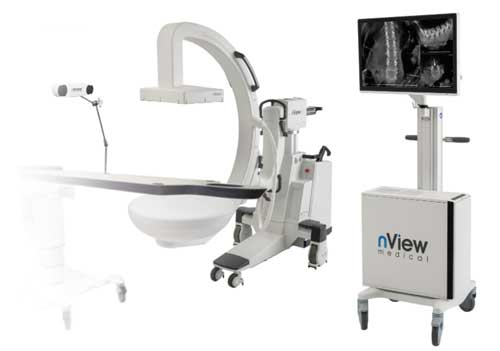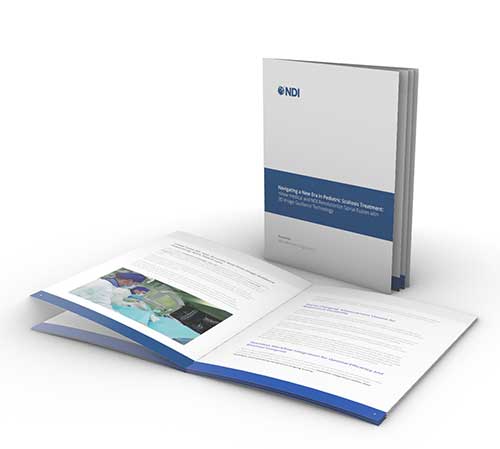Navigating a New Era in Pediatric Scoliosis Treatment: nView medical and NDI Revolutionize Spinal Fusion with 3D Image Guidance Technology
Enhance your surgical outcomes and patient safety with the future of pediatric spinal fusion – nView’s breakthrough technology, featuring NDI’s Polaris Lyra®.
Pediatric spine surgery presents unique challenges due to small patient sizes, underlying diseases, and complex anatomy. Additional considerations during pediatric surgery include minimizing risk by reducing exposure to radiation and time under anesthesia and addressing limitations of adult-focused systems on smaller anatomy.
nView medical is transforming pediatric scoliosis surgery with their nView s1™ system, specifically designed for children. In collaboration with NDI, they’ve created a safer, faster, and more accurate surgical solution.
Key Features and Benefits of nView’s s1 system include:
- 3D Imaging: Instant 3D imaging throughout surgery.
- Low Radiation: Minimized radiation exposure, safer for children.
- Real-Time Navigation: Precision and accuracy for pedicle screw placement and spinal stability.
- AI Technology: Enhanced spine imaging and curvature identification facilitates the efficient and precise placement of rods, pedicle screws, and implants, ultimately leading to safer and more efficient procedures.
Curious to learn more about the only integrated imaging and navigation system specifically designed for pediatric surgery?

Download Your Copy of the nView medical/NDI case study today.
By submitting this form, I acknowledge I’ve reviewed and accepted NDI’s privacy policy.
Navigating a New Era in Pediatric Scoliosis Treatment: nView medical and NDI Revolutionize Spinal Fusion with 3D Image Guidance Technology
Understanding Pediatric Scoliosis: Causes, Progression, and Surgical Intervention
Scoliosis, the most common spinal disorder in children and adolescents [1], occurs when the spine develops a sideways curvature into a C or S shape. This condition is usually combined with a rotation of the vertebrae and reduced kyphosis in the thoracic spine. Over time, scoliosis can progress, leading to pain and, in severe cases, potential complications involving the heart, lungs, and other organs.
Several factors, including the severity of scoliosis, the presence of concurrent complications, and the rate of curvature progression, determine the timing of surgical intervention should it be required. The most common method of surgical correction is a spinal fusion procedure. During spinal fusion, surgeons correct the curved and rotated sections of the spine by aligning them and fusing a new, stable, solid spine segment using metal rods, screws, and bone.
Child-Specific Spinal Fusion Technology for Precision and Safety
nView medical is a leading medical technology company revolutionizing pediatric scoliosis surgery. Their mission is to make spinal fusion safer, faster, and consistently accurate by creating instant 3D imaging throughout the surgery using their nView s1 system — the only integrated imaging and navigation system specifically designed for pediatric surgery.
Pediatric spine surgery presents unique challenges due to small patient sizes, underlying diseases, and complex anatomy. Accurate 3D visualization and precise instrument navigation are crucial for hardware placement, as misplaced screws could lead to inadequate spine stabilization or nerve damage.
Due to the smaller size of children, using technology designed for adults during spinal surgery results in higher radiation doses unless adjusted for their size. nView’s technology, developed specifically for children, provides a safer alternative with a fraction of the radiation dose. It addresses the limitations of adult-focused systems commonly used in pediatric spine surgery.
Every second counts during a spinal fusion. Integrating navigation technology into the imaging workflow increases image generation speed and captures real-time images in seconds instead of minutes. The combination of instant 3D imaging plus low-dose radiation technology reduces surgical times, minimizing time under anesthesia and associated risks.
These critical components are instrumental in correcting the spinal curvature associated with scoliosis and result in safer pediatric spinal fusion procedures.
nView’s innovative nView s1 system is overcoming the unique challenges of pediatric surgery, providing children with safer spinal fusion procedures and an opportunity for a better quality of life.
NDI Collaboration Enhances Navigation in nView’s Imaging Workflow
nView’s breakthrough medical imaging technologies, the nView s1™ imaging and navigation system, with its integrated proprietary insta-3D™ navigation technology, is designed to treat pediatric scoliosis and other orthopedic deformities. To meet the navigational requirements of their system, nView medical partnered with NDI (Northern Digital Inc.), a trusted industry leader in optical and electromagnetic navigation technology. The seamless integration of NDI’s compact Polaris Vicra® optical tracking camera into nView’s hardware, software, and imaging workflow proved instrumental in achieving a reduced overall footprint and fast, accurate, real-time navigation for their pediatric spinal fusion solution.

nView s1™ Technology: Combining Low Dose Radiation, AI Spine Curvature Identification and Rapid Real-Time 3D Image Guidance
The nView s1 is an advanced imaging system incorporating 3D image-guided navigation technology designed for the pediatric market. This innovative system combines the latest in MedTech advancements, including:
- quantum-dose™ technology creates 3D images with a fraction of the radiation dose.
- true-map navigation™ provides tool tracking on intraoperative 3D images throughout surgery based on a true representation of the anatomy.
- AI-driven visualization technology, including virtual-fluoroscopy™ for simultaneous visualization of multiple perspectives, a spine AI engine for automatic spine curvature identification and labeling, and 3D stitching for accurate full spine visualization without additional equipment.
- insta-3D™ provides 3D images throughout surgery without delay or the need for the system to rotate around the patient. It includes a large field of view with zoom capabilities and 3D viewports for different image perspectives.
These MedTech advancements enable nView’s system to meet necessary capabilities, including the ability to:
- Rapidly register patients and medical tools.
- Automate spine curvature identification and labeling using AI technology.
- Provide real-time accurate image guidance with minimal set-up.
- Produce accurate 3D images throughout spinal procedures without delay or a rotating C-arm.
- Operate within the constructs of a patient’s small anatomy.
- Integrate seamlessly into the operative and imaging workflow.
- Minimize X-ray radiation exposure with the proprietary low-dose radiation system.
Including these features provides tangible benefits for surgeons, as they can efficiently attain accurate full spine visualization. This capability facilitates the efficient and precise placement of rods, pedicle screws, and implants, ultimately leading to safer and more efficient procedures.
nView insta-3D: Fast, Accurate Real-Time Image Guidance Powered by NDI’s Polaris Lyra
nView medical’s navigation technology, insta-3D, is designed to make real-time 3D images quickly and safely available in the operating room when navigating, which they refer to as true-map navigation™. These images provide surgeons with better visualization of the spine, specifically the spine’s curvature and rotation. This is critical information for surgeons during a child’s spinal fusion surgery.
nView medical initially integrated NDI’s Polaris Vicra® optical tracking camera into the insta-3D component of the nView s1, providing real-time instrument navigation capabilities. However, they’ve since transitioned to NDI’s new compact optical tracking camera, the Polaris Lyra®, which delivers improved navigation functionality.
The Polaris Lyra’s responsiveness of < 5 ms and high-speed tracking up to 125 Hz enable the insta-3D technology to quickly identify and register the patient and medical instruments with sub-millimeter accuracy. Patient and instrument position and orientation are visualized in 3D on screen and tracked relative to each other in real-time throughout the spinal procedure, ensuring accurate pedicle screw placement.
The combination of nView medical’s quantum-dose™ technology and insta-3D technology minimizes X-ray radiation exposure to children, thereby improving safety for this population, which is more vulnerable to radiation.
‘Game Changing’ Measurement Volume for Anatomical Variability
nView medical considered the wide anatomical variability among patients, including small 6-year-old children with congenital conditions and fully grown adolescents with idiopathic scoliosis, during product development.
To address anatomical variability, they strategically placed the Lyra navigation camera at the foot of the surgical table. This positioning achieves the necessary camera standoff and field of view while maintaining a large measurement volume encompassing patient and instrument tracking.
The new Polaris Lyra Optical Navigation System provides an expanded measurement volume, increased accuracy, and responsiveness, which nView medical’s Chief Operating Officer, Lisa Last, calls “a game changer.”
The Lyra introduces enhanced flexibility by expanding the system’s measurement volume (range). With this increased measurement volume, the camera can be positioned farther away from the surgical field, offering a wider tracking coverage area around the surgical site to accommodate all sizes of the pediatric population. This allows patient and instrument movements to be tracked simultaneously while eliminating the need to reposition the patient or optical camera during the procedure, even when performing full-body images of adolescent patients. This enhances surgical accuracy and workflow
Seamless Workflow Integration for Optimal Efficiency and Minimal Footprint
Beyond the essential pillars of speed, accuracy, precision, and consideration for small anatomy, nView medical diligently weighed other crucial factors in their quest for optimal navigation technology. Key priorities included minimizing equipment size, ensuring seamless integration within their workflow, and upholding exceptional imaging quality.
The nVew s1 solution offers a distinct advantage over other 3D systems, with its navigation component seamlessly integrated into the imaging workflow.
This integration is made possible by the compact size of the Polaris Lyra and the insta-3D technology. Therefore, the footprint remains small, eliminating the need for an additional medical cart. This streamlined setup facilitates the effortless deployment of the nView s1 and integrated insta-3D technology in operating rooms and other clinical settings.
The nView s1 introduces breakthrough 3D imaging and navigation technology to pediatric surgery, enabling safer, faster, and more accurate pediatric scoliosis surgery. The partnership between nView medical and NDI brings a vital breakthrough in surgical care, offering the potential to significantly improve the quality of life for children.
About nView medical:
nView medical, based in Salt Lake City, UT, is a startup whose mission is to make surgery safer, faster, and consistently accurate. nView medical develops imaging systems, bringing breakthrough AI solutions for image creation, image processing, and image visualization to surgery and interventional radiology. nView medical backers include the National Science Foundation (NSF), the National Institutes of Health (NIH), the State Of Utah, the National Capital Consortium for Pediatric Device Innovation, MedTech Innovator, HealthTech Arkansas, Dr. Kevin Foley, MD, and Fusion Fund (Palo Alto, CA).
Download the Case Study: Navigating a New Era in Pediatric Scoliosis Treatment – Spinal Fusion with 3D Image Guidance Technology
Presented by nView Medical and NDI
Explore the future of pediatric scoliosis treatment with nView Medical and NDI’s revolutionary 3D image guidance technology. The nView s1™ system, designed specifically for children, offers instant 3D imaging, real-time navigation, and AI-enhanced spine imaging. This technology ensures safer, faster, and more accurate surgeries with minimized radiation exposure. Discover the only integrated imaging and navigation system tailored for pediatric surgery today.
